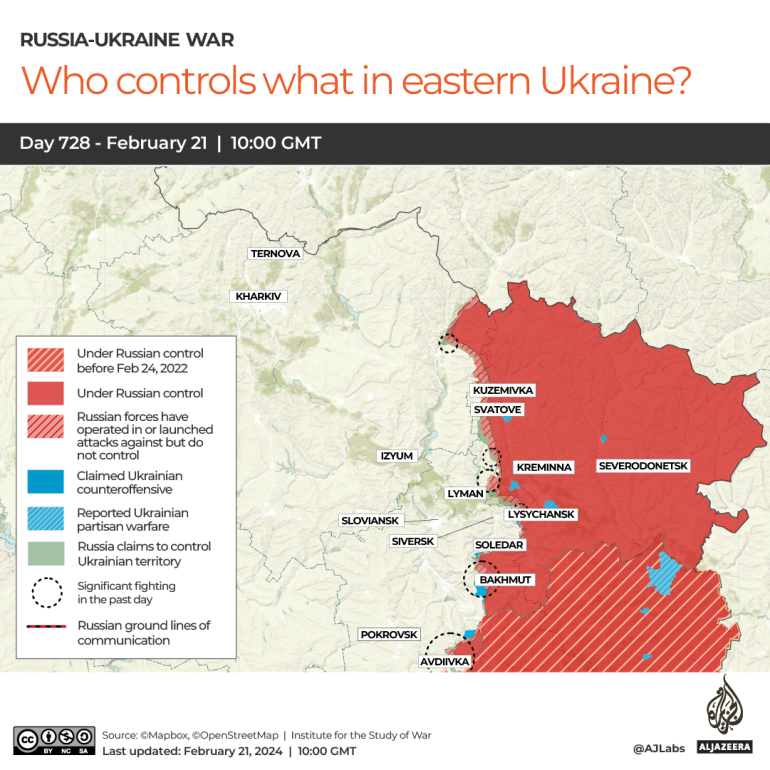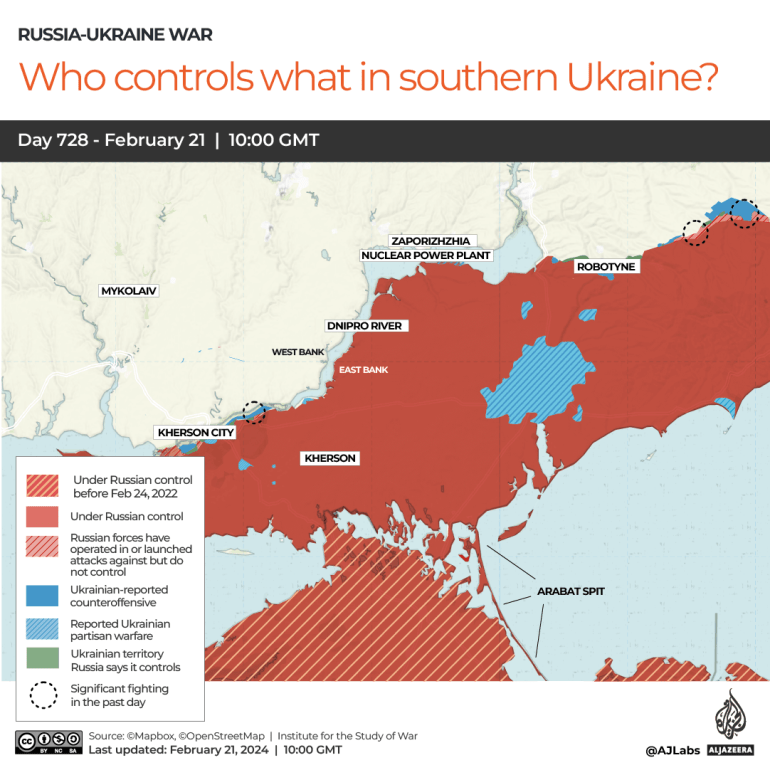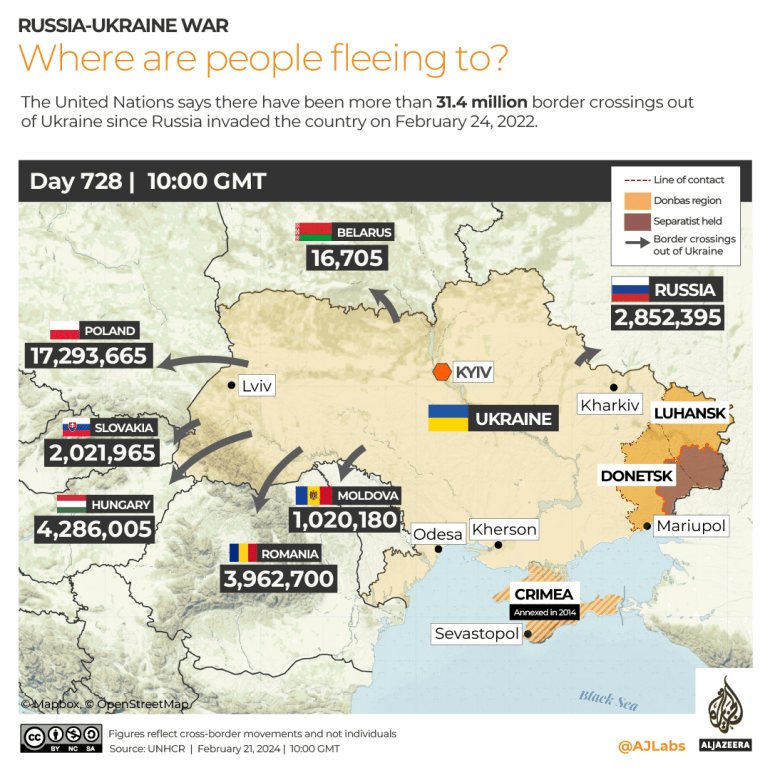Russia achieved its first major territorial success in more than nine months in the Ukraine war, capturing the eastern city of Avdiivka last week.
The once-bustling community of 30,000 civilians was gone and it was doubtful whether the local employer, Europe’s biggest coking plant, could be returned to operability soon. But the capture offered Russian President Vladimir Putin bragging rights ahead of the election he faces in March.
Russian forces began to press Ukrainian defenders in earnest last October, after Ukraine’s three-month-long summer counteroffensive had ended, promising to deal Ukraine a winter blow.
They formed a pincer to the north and south of the city, and during the four months of most intense fighting Ukraine’s Tavria forces commander, Oleksandr Tarnavskyi, estimated they had sustained 47,000 casualties, and lost 364 tanks, 248 artillery systems, 748 armoured fighting vehicles and five aircraft.
The news fell like a bombshell on the continuing Munich Security Conference, where Ukraine’s Western allies convened to survey a gloomy outlook for 2024.
“The era of peace in Europe is over,” Dmytro Kuleba, Ukrainian foreign minister, told those present.
“And every time Ukrainian soldiers withdraw from a Ukrainian town because of the lack of ammunition, think of it not only in terms of democracy and defending the world-based order, but also in terms of Russian soldiers getting a few kilometres closer to your towns.”

Ukraine’s President Volodymyr Zelenskyy also seized upon the moment to press allies for more weapons supplies.
“Unfortunately, keeping Ukraine in artificial deficits of weapons, particularly in deficits of artillery and long-range capabilities, allows Putin to adapt to the current intensity of the war. This self-weakening of democracy over time undermines our joint results,” Zelenskyy told the conference.
Many Ukrainians squarely blame the United States for the emboldening of Russia, as a $60.6bn military assistance measure for Ukraine remains stalled in Congress.
Unfortunately, keeping Ukraine in artificial deficits of weapons, particularly in deficits of artillery and long-range capabilities, allows Putin to adapt to the current intensity of the war. This self-weakening of democracy over time undermines our joint results.
— Volodymyr Zelenskyy / Володимир Зеленський (@ZelenskyyUa) February 18, 2024
“In 2022, the [US] administration [of Joe Biden] submitted funding requests in the spring, almost immediately after the invasion,” wrote Kyiv School of Economics director Tymofiy Mylovanov.
“But in 2023, it waited until mid-fall to announce what it plans to submit,” he said.
“Avdiivka demonstrates the cost of these political delays: human lives, lost territory, and encouraged Russia. If that’s the plan ‘to be with Ukraine as long as it takes’, then the US delays in aid have just prolonged the war.”
How did Russia do it?
The key to breaking the months-long impasse on the ground seems to have come from the air.
“Russian forces appear to have temporarily established limited and localised air superiority and were able to provide ground troops with close air support during the final days of their offensive operation,” said the Institute for the Study of War, a Washington-based think tank.
Sergei Shoigu, Russian defence minister, said Moscow’s forces had made 450 high-precision air strikes in the final days of the campaign for Avdiivka.
Many of those came in the form of glide bombs, massive unpowered munitions fitted with adjustable fins to travel further than ordinary inertial bombs and strike with greater precision. One Ukrainian soldier reported 60 being dropped on February 17 alone.
The use of forward air power came at a cost. Ukraine shot down two Sukhoi-34s and a Sukhoi-35 over Donetsk on Saturday as they performed sorties to drop glide bombs. On Monday they shot down another Sukhoi-34 and a Sukhoi-35 striking Ukrainian positions with glide bombs, and a Sukhoi-34 on Wednesday.
In all, Ukraine said it shot down seven planes in five days.

The first signs that Ukraine’s defences around Avdiivka were failing came on Thursday, when geolocated footage showed Russian forces advancing to new positions south of the city.
On Saturday, Ukraine’s newly appointed commander in chief, Oleksandr Syrskii, said he ordered Ukrainian units to withdraw early in the morning in order to avoid encirclement and capture. Geolocated footage showed Russian troops entering Avdiivka along a railway line running past quarries to the northeast of the city and to the coking plant in the east. By evening Russia claimed “full control” over Avdiivka.
Shoigu also claimed that Ukrainian forces had withdrawn in great disarray, suffering a large number of dead, wounded and captured men. He may have overstated the case.
The New York Times quoted unnamed Western officials confirming that a “significant” number of Ukrainian troops may have been captured. Two Ukrainian soldiers put the number at 850 to 1,000. But Tavria Group spokesman Dmytro Lykhovyi said that report was influenced by Russian information operations, and the actual number captured was much smaller.

It remains an open question whether Russian forces can keep repeating the formula that helped them capture Avdiivka in other areas of the front. Russian forces in the last week also ramped up their attacks on the eastern cities of Lyman and Kupiansk, which some observers believe are their next targets, on Robotyne, in western Zaporizhia, which Ukraine recaptured last year, and on Ukrainian positions on the left bank of the Dnipro river in Kherson.
Beyond the symbolic loss of another town, the first since Bakhmut fell in May last year, Avdiivka may offer Russia few strategic advantages.
“Avdiivka offers Russian forces limited avenues for future advance,” said the ISW. “Ukrainian forces have long fortified many of the surrounding settlements, which Russian forces are also struggling to capture.”
Western support for Ukraine
The week also brought some good news for Ukraine.
The fall of Avdiivka prompted Denmark’s prime minister to donate all of the country’s remaining artillery assets to Ukraine, prompting others to a similar shift in attitudes.
“We, Denmark, have decided to transfer all our artillery to Ukraine,” wrote Mette Frederiksen on X, formerly Twitter.
“There is military equipment in Europe … We have weapons, ammunition, air defense systems, which we do not use yet. They must be handed over to Ukraine.”
France and Germany pledged to lead an air coalition to supply Ukraine with a million First Person View drones, with a total of nine countries saying they planned to join. Germany and Ukraine signed a multi-year defence cooperation agreement including $7.5bn in defence transfers this year alone.
Lithuania said it was stepping up delivery of artillery rounds to Ukraine, and Norwegian-Finnish ammunition manufacturer Nammo said it was adopting a round-the-clock schedule at a plant in Sweden to increase the production of 155mm artillery shells for Ukraine.
NATO chief Jens Stoltenberg also said the alliance was opening a training centre for Ukrainian personnel in Poland.








